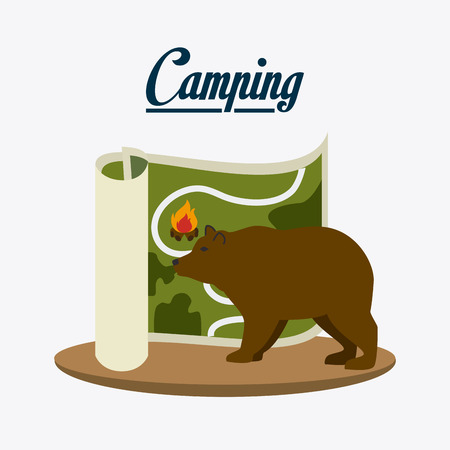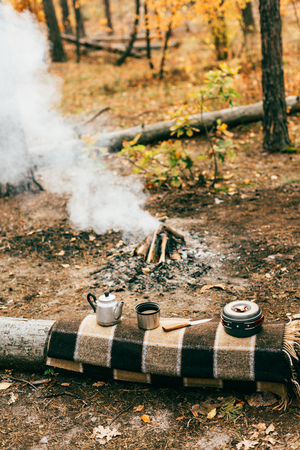1. Understanding the Importance of Food Storage
When youre heading out for your first camping trip, its easy to get caught up in packing gear and planning meals. But one thing that often gets overlooked is how to properly store your food at camp. Learning the right way to handle food in the outdoors isnt just about keeping your snacks fresh — it’s also a big part of staying safe and respecting nature.
Why Proper Food Storage Matters
In the wild, animals rely on their sense of smell to find food. Even sealed snacks, toothpaste, or scented lotions can attract wildlife like raccoons, squirrels, and even bears. Improper food storage can lead to dangerous encounters, damage to your gear, and harm to the animals themselves. Once animals associate humans with food, they become more aggressive and may have to be relocated or euthanized for safety reasons.
Top Reasons to Store Food Correctly
| Reason | Explanation |
|---|---|
| Safety | Keeping food locked away reduces the risk of attracting bears or other potentially dangerous animals to your campsite. |
| Protecting Wildlife | Wild animals that get human food may lose their natural fear of people, which can lead to conflicts and often shortens their lifespan. |
| Environmental Responsibility | Proper storage helps preserve the balance of local ecosystems by preventing animals from becoming dependent on human food. |
| Preventing Messes | No one wants their cooler raided by critters overnight! Good storage keeps your site clean and stress-free. |
Common Mistakes First-Time Campers Make
- Leaving food out overnight: Even sealed packages can attract animals if left unattended.
- Storing food in tents: This is a big no-no. Animals may try to break into your tent if they smell something interesting inside.
- Improper trash disposal: Trash should be treated like food — packed away securely and never left out.
The Golden Rule: Keep It Out of Reach
If you remember just one thing, let it be this — never leave anything edible or scented where animals can get to it. Whether youre using a bear canister, hanging a food bag in a tree, or storing everything in a car trunk (when allowed), always think about smell and access. Your safety — and theirs — depends on it.
2. Choosing the Right Food Storage Methods
When youre heading out on your first camping trip, figuring out how to store your food properly might not seem like a big deal—until a raccoon or even a bear pays you a visit. Keeping your food safe from wildlife isnt just about protecting your snacks; its about keeping animals wild and campers safe. The best storage method depends on where youre camping and what kind of wildlife lives in that area.
Common Food Storage Options
There are several tried-and-true methods campers use to keep food secure. Heres a quick overview of the most popular options and when they work best:
| Storage Method | Best For | Pros | Cons |
|---|---|---|---|
| Bear Canisters | Backcountry areas with active bear populations (e.g., national parks) | Durable, hard for animals to open, often required by law | Heavy, takes up pack space |
| Bear Bags (hung with rope system) | Remote areas without campsite amenities | Lightweight, budget-friendly | Requires trees and proper hanging skills, less secure than canisters |
| Campsite Lockers (Food Storage Lockers) | Established campgrounds with amenities | Easy to use, very secure, doesnt require extra gear | You have to be at a site that offers them |
How to Choose Based on Your Camping Location
If Youre Camping in Bear Country (like Yosemite or Glacier National Park):
A bear canister is usually required and is your safest bet. Check with park regulations before you go—some parks even rent them out if you don’t want to buy one.
If Youre Backpacking in Remote Areas:
A lightweight bear bag could work if there are no regulations requiring canisters. Make sure you learn the PCT hang method or similar techniques to do it right.
If You’re at an Established Campground:
Look for metal food storage lockers at your site. Use them every time—even for toothpaste or snacks. Don’t leave anything scented in your tent!
Bonus Tip: Always Store Food Away from Sleeping Area
No matter which method you choose, make sure your food storage is at least 100 feet (about 30 meters) away from your tent. This keeps curious critters from sniffing around where you sleep.
Selecting the right food storage method isn’t just about convenience—it’s about safety for both you and the wildlife. Knowing what works best where youre going will help you enjoy your camping trip with peace of mind.

3. Food Items to Keep Out of Reach
When youre camping for the first time, it might surprise you how many everyday items can attract wildlife. Animals like bears, raccoons, and even squirrels have an incredible sense of smell and are always on the lookout for a free meal. Its not just your sandwiches or marshmallows—theyre also drawn to things you might not think of as “food.”
Common Attractants to Be Aware Of
Here’s a breakdown of common food-related items that should always be stored safely away from your tent and out of reach of animals:
| Item | Why It Attracts Wildlife | Proper Storage Tips |
|---|---|---|
| Snacks (chips, trail mix, granola bars) | Strong smells and high sugar/fat content | Store in bear-proof containers or hang in a bear bag at least 10 feet off the ground and 4 feet from tree trunks |
| Cooked Meals & Leftovers | The strongest food odors come from cooked meals | Never leave food unattended; clean up immediately after eating and store leftovers properly |
| Cooking Utensils & Cookware | Residue left on pots, pans, spatulas, etc. | Wash thoroughly after use and store with other scented items away from sleeping area |
| Scented Toiletries (toothpaste, sunscreen, lotion) | Sweet or fruity scents mimic food smells to wildlife | Treat like food—store in the same secure container or bear bag as actual food items |
| Beverages (especially sugary drinks and alcohol) | Sugar content and fermentation can attract animals like bears and raccoons | Keep sealed when not in use; store with food at night or when leaving camp |
| Trash & Food Packaging | Even empty wrappers carry lingering scents that attract animals | Dispose of trash in designated wildlife-proof bins or pack it out in sealed bags if necessary |
A Good Rule of Thumb
If it smells like something you’d want to eat—or wear—it probably smells good to wildlife too. Always treat anything with a scent as a potential attractant.
Pro Tip:
Create a “scent-free zone” around your tent by never storing any food or scented products inside. Set up a separate cooking and storage area at least 200 feet downwind from where you sleep.
Remember:
Your safety—and the safety of local wildlife—depends on keeping all attractants securely stored. A curious animal might just wander through camp if it smells something tasty.
4. Setting Up Camp with Wildlife in Mind
When youre camping for the first time, its easy to focus on finding a flat spot for your tent and getting your campfire going. But if youre in bear country—or really any area with wild animals—how you set up your campsite can make a big difference in staying safe and keeping wildlife away.
The 100-Yard Triangle Principle
A good rule to follow is the “100-yard triangle” setup. This means you should separate your campsite into three distinct areas:
- Sleeping Area: Where you set up your tent and sleep.
- Cooking Area: Where you prepare, cook, and eat food.
- Food Storage Area: Where you store all food, trash, and scented items like toothpaste or sunscreen.
Each of these areas should be about 100 yards (roughly the length of a football field) apart from one another, forming a triangle. This helps reduce the chance that smells from cooking or food attract animals to where youre sleeping.
Why It Matters
Wildlife, especially bears, have an incredible sense of smell. If they catch a scent near your tent, they might come looking—even if there’s no actual food there. Keeping your food and cooking area far from where you sleep adds an important layer of protection.
Campsite Layout Example
| Area | Description | Distance from Tent |
|---|---|---|
| Tent/Sleeping Area | Your personal space for resting. Keep it scent-free. | N/A (Central Point) |
| Cooking Area | A place for preparing and eating meals. Clean thoroughly after use. | 100 yards away |
| Food Storage Area | A secure location for storing all food and scented items—ideally in a bear locker or hung properly in a tree. | 100 yards away (different direction from cooking area) |
Extra Tips for Wildlife-Smart Campsites
- Avoid setting up near animal trails or water sources.
- Keep your tent free of any food or scented products.
- If using bear spray, keep it accessible at night.
- If allowed, use bear-proof containers or hang your food properly.
This kind of setup might seem like extra work at first, but it quickly becomes second nature—and it’s worth it to keep both you and the wildlife safe.
5. Tips for Wildlife Encounters and Emergency Preparedness
When youre camping for the first time, its important to know how to handle unexpected wildlife encounters. Animals like bears, raccoons, or even snakes might wander into your campsite if they smell food or get curious. Here’s how you can be prepared and stay safe.
What to Do If a Wild Animal Approaches
If you see a wild animal near your campsite, stay calm. Don’t run or scream—this could provoke the animal. Instead, follow these basic safety steps depending on the type of animal:
| Animal | What to Do |
|---|---|
| Bear | Stand tall, speak firmly, and slowly back away. Never turn your back. If it gets closer, use bear spray. |
| Raccoon | Make loud noises like clapping or banging pots to scare it off. Never feed them. |
| Snake | Stay still or slowly move away. Don’t try to touch or move the snake. |
Essential Safety Tools to Keep at Your Campsite
Packing smart can make all the difference in an emergency. These items are small but powerful when it comes to safety in the wild:
- Bear Spray: A must-have in bear country. Keep it accessible—not in your backpack.
- Whistle: Can help scare off animals or signal for help.
- Flashlight or Headlamp: Useful for spotting animals at night and staying aware of your surroundings.
- First Aid Kit: Always have one ready for minor injuries.
- Emergency Contact Info: Write it down and keep it in your tent or backpack.
Practice Safe Food Storage
The best way to avoid wildlife encounters is by preventing them in the first place. Store food properly by using bear-proof containers or hanging your food high in a tree if no storage lockers are available. Never store food inside your tent.
Quick Checklist Before Bedtime:
- All food stored securely away from sleeping area
- No trash left out—dispose of properly or pack it out
- Campsite clean of crumbs and leftovers
- Scented items (toothpaste, deodorant) stored with food
By preparing ahead and knowing how to react calmly, you can enjoy a safe camping trip without unwanted wildlife surprises.


